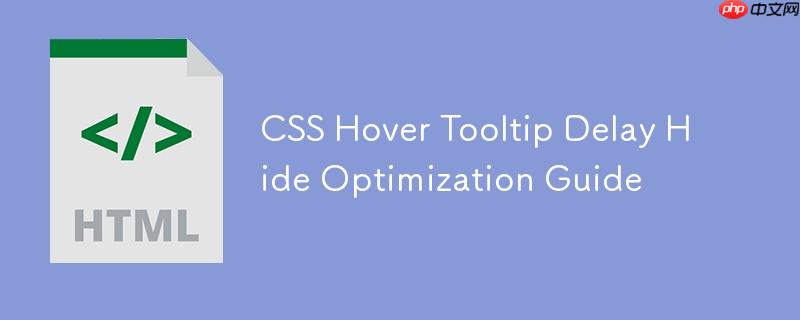
在网页开发中,工具提示(tooltip)是一种常见的交互元素,它在用户将鼠标悬停在特定元素上时显示额外信息。然而,一个常见的问题是,当鼠标从触发元素移向弹出的工具提示本身时,提示框会过早消失,导致用户无法将鼠标移动到提示框内进行交互或阅读。这通常是由于悬停状态在鼠标离开触发元素瞬间丢失所致,尤其在使用 display: none 来控制提示框显示/隐藏时,传统的 transition-delay 方案难以奏效。
本教程将介绍一种纯 CSS 的解决方案,通过巧妙地利用伪元素(::before)和内边距(padding)来扩展悬停区域,从而有效地延迟工具提示的隐藏,显著提升用户体验。
假设我们有一个基于 <sup> 标签的脚注工具提示,其基本 HTML 结构和 CSS 样式如下:
HTML 结构示例:
<p>another line</p>
<p>
Dies ist ein Beispiel für eine Fußnote in HTML
<sup class="footnote" data-count="1">
<cite>
<span> [Sample span]</span> with some explanation:
<a lang="en" href="http://test.gv.at/test.pdf">
http://test.gv.at/test/test/abde4/iabcde/009909asdf/vandsfk23/verylong/gghhy.pdf
</a>
</cite>
</sup> Dies ist ein Beispiel für eine Fußnote in HTML
</p>
<p>another line</p>初始 CSS 样式:
立即学习“前端免费学习笔记(深入)”;
sup.footnote::after {
content: attr(data-count);
}
sup.footnote:hover {
cursor: help;
position: relative; /* 确保 cite 元素的绝对定位参照此元素 */
}
sup.footnote cite {
display: none; /* 默认隐藏 */
}
sup.footnote:hover cite {
display: inline-block; /* 悬停时显示 */
position: absolute;
top: 0px;
left: -50%; /* 初始定位,可能需要调整 */
width: 250px;
background: #f0f0f0 no-repeat 100% 5%;
border: #c0c0c0 1px dotted;
border-radius: 8px;
margin: 10px;
padding: 8px;
overflow: hidden;
}
sup.footnote cite a {
text-overflow: ellipsis;
white-space: nowrap;
overflow: hidden;
display: block;
}在这种实现中,当鼠标悬停在 sup.footnote 元素上时,其内部的 cite 元素会显示出来。然而,一旦鼠标稍微移出 sup.footnote 元素的边界,即使是向着弹出的 cite 元素方向移动,sup.footnote:hover 状态也会立即失效,导致 cite 元素因 display: none 而瞬间隐藏。这极大地影响了用户体验,使得用户难以将鼠标顺利地移动到提示框内部。
为了解决这个问题,我们可以利用 ::before 或 ::after 伪元素在 sup.footnote 元素周围创建一个不可见的“缓冲区”。这个缓冲区将与 sup.footnote 共享相同的悬停状态,从而在鼠标离开 sup.footnote 元素本身但仍处于缓冲区内时,保持 :hover 状态的激活。
核心思路:
实现步骤与代码:
首先,我们需要在 sup.footnote 上确保 position: relative,这是伪元素绝对定位的基础。然后,添加一个新的 ::before 伪元素样式:
/* 新增样式:扩展悬停区域 */
sup.footnote {
position: relative; /* 确保此元素是伪元素的定位上下文 */
}
sup.footnote::before {
content: ''; /* 伪元素必须有 content 属性 */
height: 100%;
width: 100%;
position: absolute;
/* 通过 padding 扩展悬停区域 */
padding-right: 0.5em; /* 向右扩展 */
padding-bottom: 0.5em; /* 向下扩展 */
/* 可以根据需要添加 padding-left 和 padding-top */
top: 0; /* 确保伪元素从父元素的左上角开始 */
left: 0;
/* z-index 确保伪元素不会遮挡其他交互元素,通常与父元素相同或更高 */
z-index: 1; /* 确保它在父元素上方但低于 tooltip 本身 */
}完整的 CSS 代码:
将上述新增样式整合到原有的 CSS 中,并对 cite 元素的 left 属性进行微调,以更好地适应扩展后的悬停区域。
/* 基础样式 */
sup.footnote {
position: relative; /* 确保此元素是伪元素的定位上下文 */
}
sup.footnote::after {
content: attr(data-count);
}
/* 新增样式:扩展悬停区域 */
sup.footnote::before {
content: '';
height: 100%;
width: 100%;
position: absolute;
padding-right: 0.5em; /* 向右扩展 */
padding-bottom: 0.5em; /* 向下扩展 */
top: 0;
left: 0;
z-index: 1; /* 确保在父元素上方 */
}
/* 悬停状态样式 */
sup.footnote:hover {
cursor: help;
/* position: relative; 已经设置在基础样式中 */
}
sup.footnote cite {
display: none;
}
sup.footnote:hover cite {
display: inline-block;
position: absolute;
top: 0px;
left: -20%; /* 调整 tooltip 的水平位置,以适应扩展区域 */
width: 250px;
background: #f0f0f0 no-repeat 100% 5%;
border: #c0c0c0 1px dotted;
border-radius: 8px;
margin: 10px;
padding: 8px;
overflow: hidden;
z-index: 2; /* 确保 tooltip 显示在伪元素和父元素之上 */
}
sup.footnote cite a {
text-overflow: ellipsis;
white-space: nowrap;
overflow: hidden;
display: block;
}HTML 保持不变:
<p>another line</p>
<p>
Dies ist ein Beispiel für eine Fußnote in HTML
<sup class="footnote" data-count="1">
<cite>
<span> [Sample span]</span> with some explanation:
<a lang="en" href="http://test.gv.at/test.pdf">
http://test.gv.at/test/test/abde4/iabcde/009909asdf/vandsfk23/verylong/gghhy.pdf
</a>
</cite>
</sup> Dies ist ein Beispiel für eine Fußnote in HTML
</p>
<p>another line</p>通过利用 CSS 伪元素 ::before 及其 padding 属性,我们成功地为工具提示的触发元素创建了一个扩展的悬停区域。这种方法有效地解决了鼠标从触发元素移向工具提示时,提示框过早隐藏的问题,显著提升了用户交互的流畅性和用户体验。这种纯 CSS 方案简洁高效,避免了使用 JavaScript 带来的额外复杂性,是实现延迟隐藏工具提示的专业而优雅的选择。
以上就是CSS 悬停工具提示延迟隐藏优化指南的详细内容,更多请关注php中文网其它相关文章!

每个人都需要一台速度更快、更稳定的 PC。随着时间的推移,垃圾文件、旧注册表数据和不必要的后台进程会占用资源并降低性能。幸运的是,许多工具可以让 Windows 保持平稳运行。

Copyright 2014-2025 https://www.php.cn/ All Rights Reserved | php.cn | 湘ICP备2023035733号